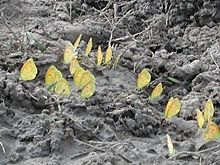Eurema nicippe
Appearance
| Sleepy orange | |
|---|---|

| |

| |
| Scientific classification | |
| Domain: | Eukaryota |
| Kingdom: | Animalia |
| Phylum: | Arthropoda |
| Class: | Insecta |
| Order: | Lepidoptera |
| Family: | Pieridae |
| Genus: | Eurema |
| Species: | E. nicippe
|
| Binomial name | |
| Eurema nicippe (Cramer, 1779)
| |
| Synonyms | |
| |
Eurema nicippe, the sleepy orange, is a North American
United States-Mexico border, and it often travels further to non-mountainous regions of the southeastern United States[3]
.
Description

The sleepy orange is a bright orange butterfly with the upperside of the
forewing costal margin has a small, narrow black marking that resembles a closed eye. Contrary to popular belief, its name originates from this wing patterning, rather than its behavior; the butterfly has a very rapid flight pattern when disturbed[4]. The underside of the wings varies seasonally: summer forms are bright yellow with brick-red markings, while winter forms are browner and more heavily marked. It has a wingspan of 13⁄8–21⁄4 inches (35–50 mm)[5]
.
Habitat
The sleepy orange generally prefers low elevation areas[3], agricultural land, and disturbed sites[5], and may be found in or around old fields, roadsides, woods edges, swamps, wet meadows, open woodlands, margins of ponds, waterways, and valleys.[4]
Life cycle
Its
eggs are spindle-shaped and white in color when first laid, but quickly turn yellow[4]. They are laid on the underside of the leaves of its host plant, often members of the legume family[6]. The larva is pale green with a narrow white stripe along its length on either side and very short hairs[4]. The chrysalis varies from pale green[7] to brown-black later in its life cycle[5]. They have two to four broods per year. They can be found year-round further south, but migrate north during the warmer summer months[8]
.
Host plants
- Partridge pea, Chamaecrista fasciculata
- Wild sensitive plant, Chamaecrista nictitans
- Senna hebecarpa
- Privet senna, Senna ligustrina
- Senna marilandica
- Senna mexicana
- Senna obtusifolia
Similar species
- Colias eurytheme - orange sulphur
- Eurema proterpia - tailed orange
References
- . Retrieved 6 December 2022.
- ^ "NatureServe Explorer 2.0 Abaeis nicippe Sleepy Orange". explorer.natureserve.org. Retrieved 3 October 2020.
- ^ a b "Sleepy Orange Abaeis nicippe (Cramer, 1779)". Butterflies and Moths of North America. June 10, 2024. Retrieved June 10, 2024.
- ^ a b c d "Sleepy Orange". Alabama Butterfly Atlas. June 10, 2024. Retrieved June 10, 2024.
- ^ a b c "Florida's Wildflowers & Butterflies | Sleepy Orange". Florida Museum of Natural History. Retrieved 2024-06-10.
- ^ "Sleepy Orange - Pollinator Web". 2023-04-14. Retrieved 2024-06-10.
- ^ Krotzer, Steve and Mary Jane. "Sleepy Orange". Haysop Hill Photography. Retrieved June 10, 2024.
- ^ Webmaster, David Ratz. "Sleepy Orange - Montana Field Guide". fieldguide.mt.gov. Retrieved 2024-06-10.
- Jim P. Brock, Kenn Kaufman (2003). Butterflies of North America. Boston: Houghton Mifflin. ISBN 0-618-15312-8.
- James A. Scott (1986). The Butterflies of North America. Stanford University Press, Stanford, California. ISBN 0-8047-2013-4
- Ernest M. Shull (1987). The Butterflies of Indiana. Indiana Academy of Science. ISBN 0-253-31292-2
- Rick Cech and Guy Tudor (2005). Butterflies of the East Coast. Princeton University Press, Princeton, New Jersey. ISBN 0-691-09055-6
- David L. Wagner (2005). Caterpillars of Eastern North America. Princeton University Press, Princeton, New Jersey. ISBN 0-691-12143-5


